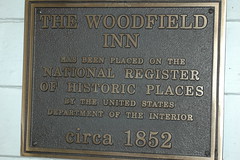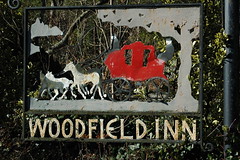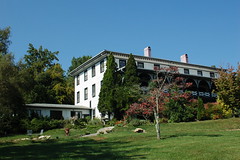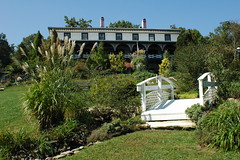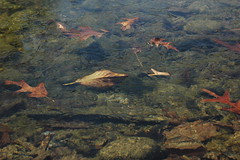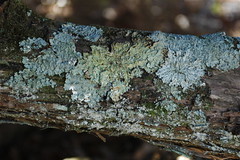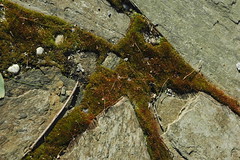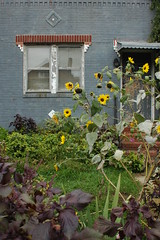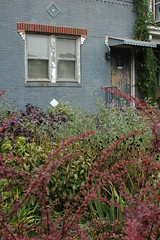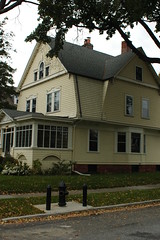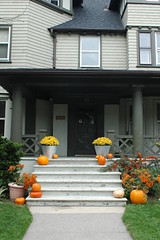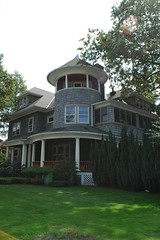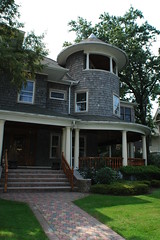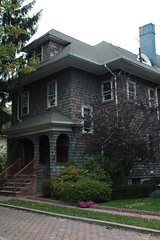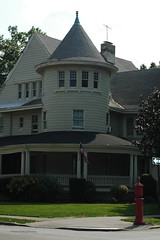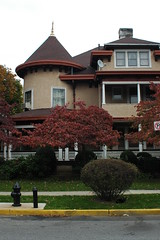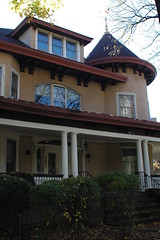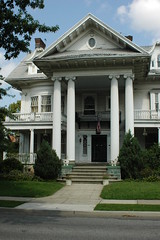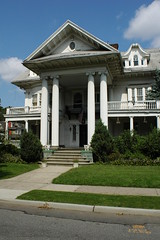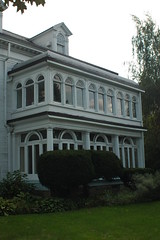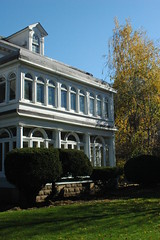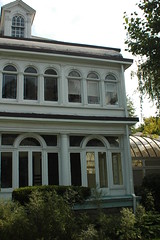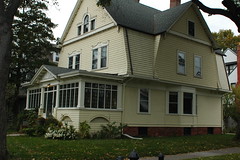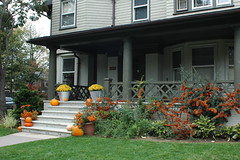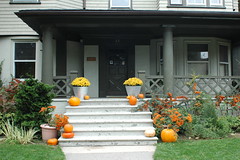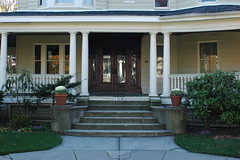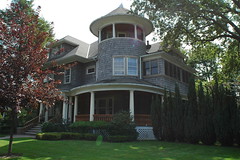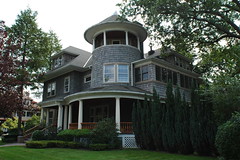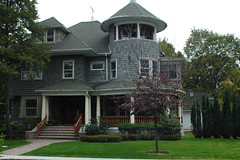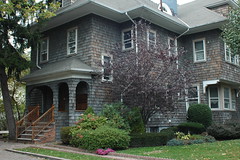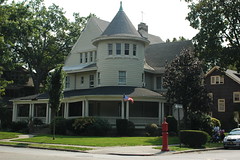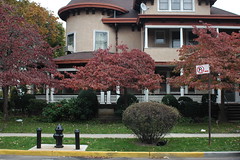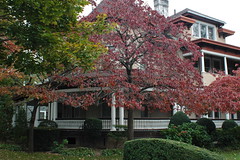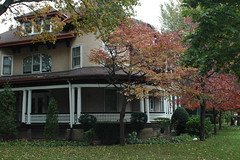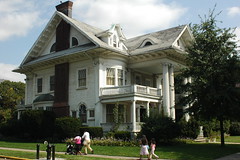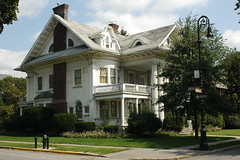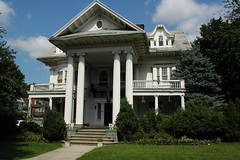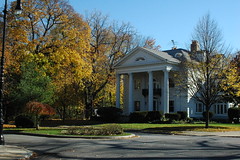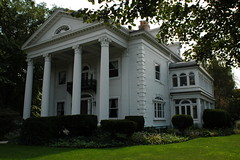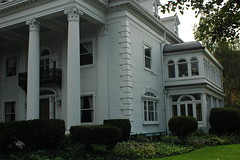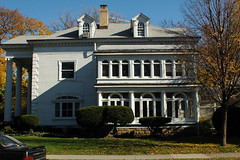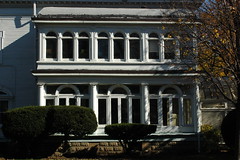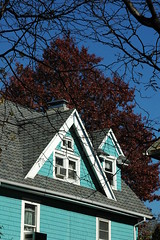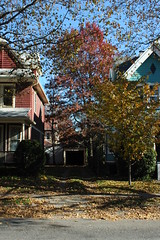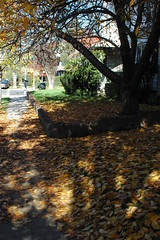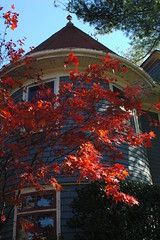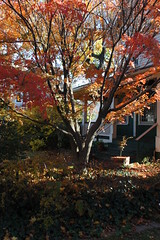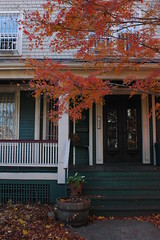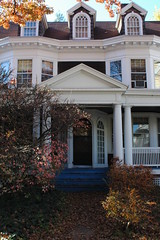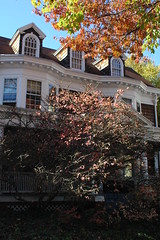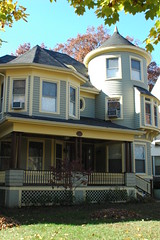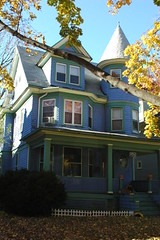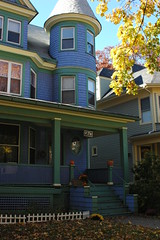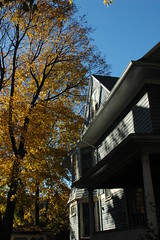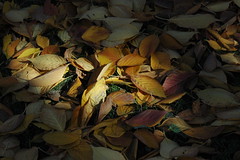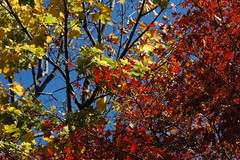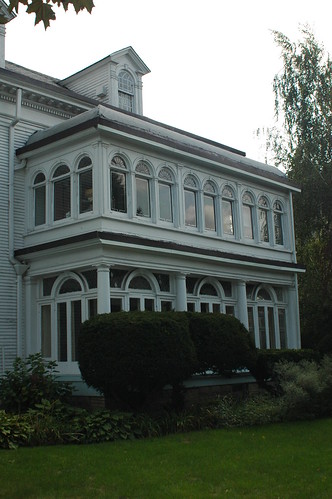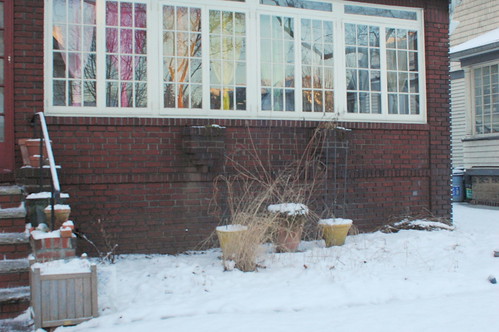 Here’s a bonus shot of the front garden I took this morning, with last night’s snowfall still fresh on the ground. You can see the current “bones” more clearly here.
Here’s a bonus shot of the front garden I took this morning, with last night’s snowfall still fresh on the ground. You can see the current “bones” more clearly here.
Tag Archives: Photos
The Front Garden Evolving
[Updated 2007.02.20: Added links to Related Posts at the end of this one.]
Here’s a series of photos showing how the front garden has evolved so far, from when we closed on our house in Spring of 2005, to this past fall. This is one of the four gardens – one for each side of the house – I’ve written about previously. This will be the heirloom garden. The house was built in 1900. I’ll be relying as much as possible on plants which were available in 1905 or earlier.
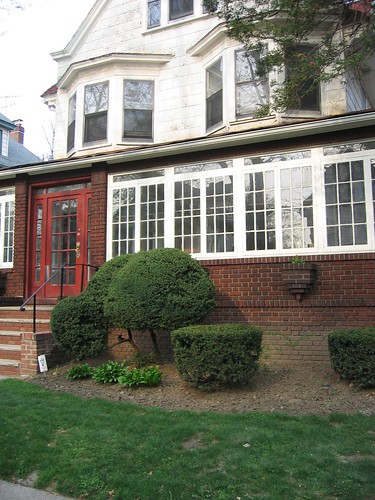 This is what the front yard looked like when we closed on the house. Half the depth is devoted to a small lawn. The planting bed held a boxwood, two yews, a few hostas, and nothing else. There was not even a single daffodil bulb.
This is what the front yard looked like when we closed on the house. Half the depth is devoted to a small lawn. The planting bed held a boxwood, two yews, a few hostas, and nothing else. There was not even a single daffodil bulb.
There was also a full-grown white cedar at the corner of the front porch. You can see its foliage at the upper-right of this photo. The cedar was beautiful, and huge – taller than the house – but it was in the wrong place. The trunk was pressing against the porch roof, so it had to go. It was obviously planted as a foundation plant decades ago, without regard for how tall it would get.
 Here’s a detail of the brickwork to the left of the front steps, in front of the mud room. Note the built-in planter on the porch wall. Another is visible in the photo above, and there’s a third hidden behind the boxwood. One of my initial goals was to open up the plantings along the front of the house to expose and highlight the brickwork.
Here’s a detail of the brickwork to the left of the front steps, in front of the mud room. Note the built-in planter on the porch wall. Another is visible in the photo above, and there’s a third hidden behind the boxwood. One of my initial goals was to open up the plantings along the front of the house to expose and highlight the brickwork.
 Here’s the garden a month later. The boxwood and yews have been removed, as well as the cedar. You can now see the other planter, and the beautiful brickwork along the front of the house. The repetition in the windows and the horizontal lines of the brick details are more typical of Arts&Crafts than Victorian architecture. This is one of the reasons why I believe the front porch was enclosed early in the life of the house, and worth preserving.
Here’s the garden a month later. The boxwood and yews have been removed, as well as the cedar. You can now see the other planter, and the beautiful brickwork along the front of the house. The repetition in the windows and the horizontal lines of the brick details are more typical of Arts&Crafts than Victorian architecture. This is one of the reasons why I believe the front porch was enclosed early in the life of the house, and worth preserving.
On the right, the mulch on the ground is part of what’s left of the cedar. I also kept four logs from the lowest section of the trunk. I’m using these now as seating in the backyard, which gives you some idea of the trunk this tree had. I hope to eventually incorporate the wood into something else for the garden.
 And another month later, in June of 2005. There’s some more plants which I moved from Garden #3. I put up the rainbow of silks to mark Gay Pride month.
And another month later, in June of 2005. There’s some more plants which I moved from Garden #3. I put up the rainbow of silks to mark Gay Pride month.
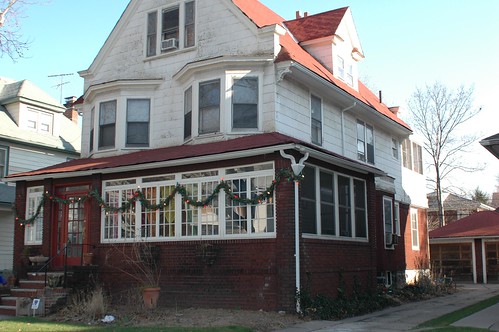 Winter of 2006. I had started playing around with some containers in the front yard. You can also see the south side of the house, which doesn’t have too much going on yet. And of course the old-school big-bulb Christmas lights and garland.
Winter of 2006. I had started playing around with some containers in the front yard. You can also see the south side of the house, which doesn’t have too much going on yet. And of course the old-school big-bulb Christmas lights and garland.
 May of 2006. More planters, especially on and around the steps. You can see the last of the heirloom Tulips to the right of the steps. The silks have faded a lot from the previous year.
May of 2006. More planters, especially on and around the steps. You can see the last of the heirloom Tulips to the right of the steps. The silks have faded a lot from the previous year.
I started putting in some stepping stones to edge the lawn and planting area, both as a shortcut path across the lawn, and to guide my push mower.
 September of 2006. Lots of containers now. I’ve finished the path across the front lawn, and put in some hose guides. The red and yellow flowers in the large terra-cotta pot to the right of the front steps is Canna “Cleopatra”. The Hosta are blooming. The tall pink and purple flowers are Cleome, Spider Flower, I grew from seed given to me by a gardener from Long Island.
September of 2006. Lots of containers now. I’ve finished the path across the front lawn, and put in some hose guides. The red and yellow flowers in the large terra-cotta pot to the right of the front steps is Canna “Cleopatra”. The Hosta are blooming. The tall pink and purple flowers are Cleome, Spider Flower, I grew from seed given to me by a gardener from Long Island.
I’m still working my way across the front yard. One reason I haven’t finished more is that we have to replace the roof this year. A complete tear-down, which means lots of debris on all sides of the house. Which means lots of smushed plants. Hopefully we can get the roof replaced early enough in the year that I can still get a good growing season in, and finish the front garden.
Related Posts:
- January 29, 2007: The Front Garden This Morning
- August 19, 2006: Heirloom Plant Profile: Canna “Cleopatra”
- June 9, 2006: The Fourth Gardens
- April 30, 2006: Four Gardens Revisited
Woodfield Inn, Flat Rock, North Carolina
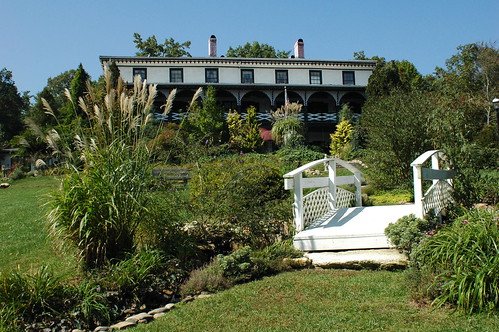
Photos of the exterior, grounds, and gardens of the historic Woodfield Inn [defunct] in Flat Rock, North Carolina. These photos are from October of last year and this past Saturday, when we threw a party for my parents’s 50th Anniversary.
I could use some help from my gardening buddies in identifying the foliage, berries and plants. I’m not so good on woody plant identification.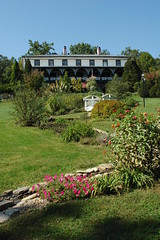
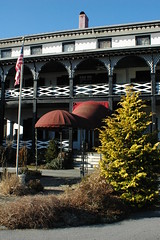
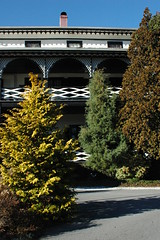
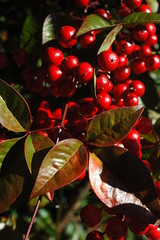

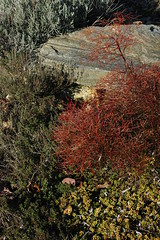
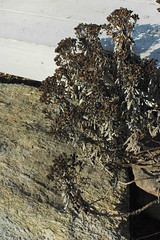
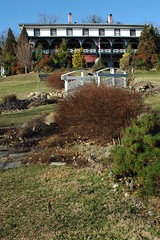
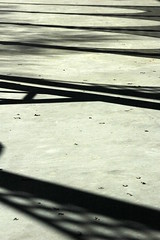

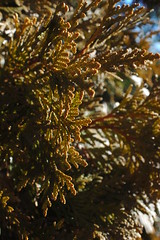
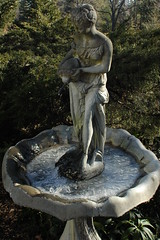
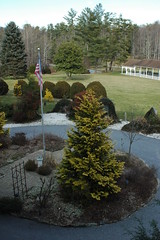
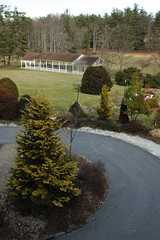
Related Content
Fall Color along Albemarle Road in Prospect Park South
Possibly the most photogenic block in all of Brooklyn. I took most of these photos this season, in September, October and this month.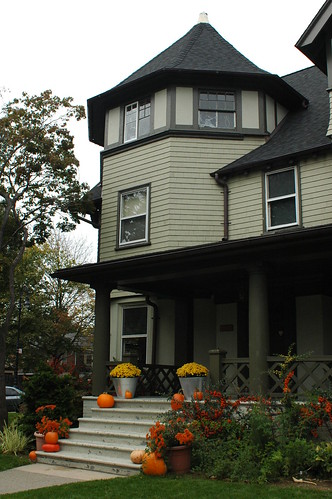
The title of this posting links to the Flickr set of these photos: Albemarle Road, Prospect Park South. Each photo in this post links to its photo page in Flickr, where you can view it at several different resolutions.
The photos are organized so you can take your own walking tour. In the Flickr set, the photos are ordered by street address; the street addresses increase going east from Coney Island Avenue. All the photos are also geotagged on Flickr, so you can see where each photo was taken. Look for the “map” link on the individual photo pages.
More Fall Color in Beverley Square West
I’m afraid I missed the peak leafage in my neighborhood this year, at least as far as a photographic record is concerned. I didn’t get out into the neighborhood last weekend; I was at the Brooklyn Botanic Garden on Satruday, and waiting all day on Sunday for the cable guy. Wednesday we had heavy rains all day, which knocked down a lot of leaves.
But we had a beautiful day today, so it was a good excuse to get out and see what color I could still find. You can see there was still some good color out there.
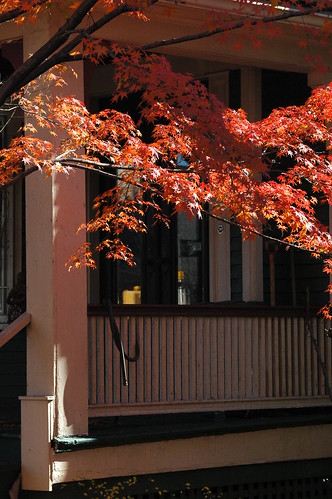 1422 Beverly Road. I have several photos from this house in this set. It has a lovely shady front-yard garden. I walk past this house every day, to and from the subway to work. I’ve yet to introduce myself to the gardener who lives there.
1422 Beverly Road. I have several photos from this house in this set. It has a lovely shady front-yard garden. I walk past this house every day, to and from the subway to work. I’ve yet to introduce myself to the gardener who lives there.
Each photo in this post links to its photo page on Flickr, where you can view it at several different resolutions.
Related Content
Happy Halloween!
[2006.11.01 18:00 EST: Linked to The Farm.]
[2006.11.01 16:00 EST: Described t-shirt text.]
[2006.10.31 23:00 EST: Updated with photos from the rest of the evening. Mwa-ha-ha-ha!]
It was a great day. I walked to the subway through the cemetery at Trinity Church. There was a magnificent sunset. Over 330 trick-or-treaters. All candy gone. We went out to dinner at The Farm at on Adderley on Cortelyou Road, where most of the staff and many guests, including me, were in costume.
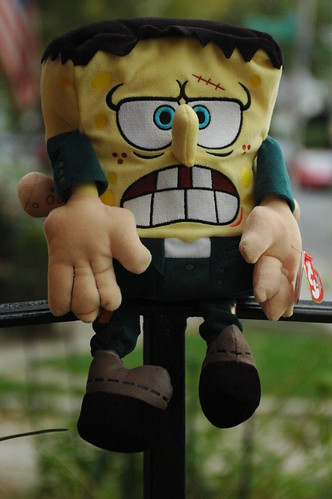 Over 33 pounds and 1,695 pieces of candy: $50 (estimated)
Over 33 pounds and 1,695 pieces of candy: $50 (estimated)
Wigs, makeup, ghoul teeth: $60 (approximate)
Seeing small children freeze in shock and hearing their shrieks of gleeful terror as they look up at your hideous face:
PRICELESS The t-shirt has a drawing of a leering devil on it. The text reads: God’s busy. Can I help you?
The t-shirt has a drawing of a leering devil on it. The text reads: God’s busy. Can I help you?
T&L “Discovers” Brooklyn
I visited Coney Island for the first time this past April. This is a view at dusk from the elevated subway platform.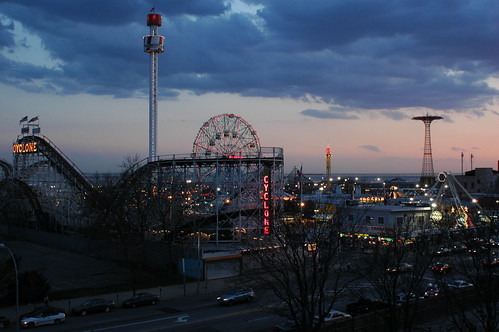
A cover story of the November issue of Travel & Leisure magazine is “Brooklyn-Bound”. My emphasis added:
I wonder if curious visitors aren’t coming with misplaced expectations. If someone told you Brooklyn is “the next Manhattan,” they got it dead wrong. Brooklyn is nothing like Manhattan. Brooklyn looks and feels and is like no place else.
The first thing you need to know about Brooklyn is that it is huge: New York’s most populous borough, home to nearly a third of its citizens. An independent Brooklyn would be the nation’s fourth-largest city. Brooklyn is a vast metropolis blessed and cursed to lie 500 yards from Manhattan.
The second thing you need to know about Brooklyn is that it is small. Big in breadth and attitude, but intimate in the height of its buildings, the modesty of its storefronts, the compactness of its communities. Defined by the stoop, the bodega, the bocce or basketball court, Brooklyn has an enduring neighborhood-ness. Come to my block next month and they’ll be decking the stoops for Christmas; come in June, and the kids next door will be manning a lemonade stand.
– Brooklyn-Bound, November issue of Travel & Leisure magazine
Or come to my front door tomorrow evening. We stocked up on over 30 pounds of candy over the weekend. Halloween is big in this neighborhood.
Thanks to The Gowanus Lounge for bringing this to my attention.
Fall Color in Beverley Square West
“You know, for a gardening blog, there’s not much about gardening …” – What I imagine you all must be thinking by now.
I’ve got lots of stuff, honestly. I’m just really back-logged with everything I want to write about. Just not enough hours in the day, especially workdays!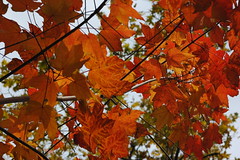

But here’s a little something: some photos of the developing fall color in my neighborhood, Beverly Square West, one of the neighborhoods of the larger area known as Victorian Flatbush. Yes, this is Brooklyn.







Related Content
North Carolina Arboretum: 2 of 2, Bonsai Exhibition House
Bonsai, “Yoshimura Island,” American Hornbeam, Carpinus caroliniana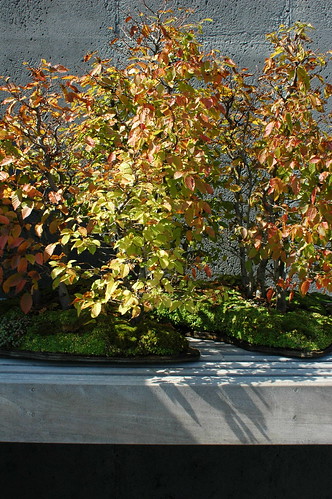
I’ve been to the Asheville area a couple of times over the past several years. I try to visit the North Carolina Arboretum each time I’m in the area, but I don’t always get the chance. On this visit, I was struck by the new Bonsai Exhibition House, which is across the courtyard from the Visitor Education Center, the main building on the site. If you find yourself anywhere in the Asheville area, and have any interest in plants or gardens, this should be a stop during your visit.
The design and layout of the “House” is impressive. All of the specimens are displayed outdoors, at least at this time of year. In past years, they’ve been available for viewing in one of the greenhouses, which is located about a mile down the road from the Visitor Center.
It’s really an outdoor garden demonstrating different classical Japanese and Chinese garden design principles, with explanatory signage along the way. There’s a winding wheelchair-accessible path which can be accessed from either the upper entrance, near the Visitor Center, or the lower entrance.

There are also walls with lots and lots of shelves and nooks for displaying the bonsai. The poured, formed concrete is a minimalist neutral grey, which serves as a non-distracting backdrop for the bonsai, highlighting their textures, colors, and forms.
Finally, the individual specimens are exemplary and exquisite, covering every form, from snags, to broad, fully-leaved single specimens, to groves, and even complete forests in miniature. One even benefited from a visiting “dragon” while we were there.
Links
Conservatory Envy
I volunteered this past week at our neighborhood association meeting to photograph houses at risk due to inappropriate zoning in our area. So today I walked around my neck of the woods in Victorian Flatbush in Brooklyn with my camera and two lenses: my standard lens, a 28-85mm zoom, and my wide angle 20mm lens.
Of course, I took some photos for my own enjoyment as well, especially because I got to walk through the landmark district of Prospect Park South. I thought I’d share this house in particular with my gardening buddies out there.
How do you like this two-story conservatory? It’s hard to see unless you look at the full size picture, but those are leaded glass sunburst fanlight windows above the regular windows on the second story, and the same with diamond-pane leaded glass windows above on the first floor.
If that’s not enough, you could always expand into the attached greenhouse in the back of the house.
Here’s a view of the facade of the house. You can see the conservatory on the right side. I think we can devise more creative plantings than clipped yews to complement the two-story fluted corinthian columns gracing the front of the house.
What do you think, readers? Does this look like an opportunity? A diamond in the rough? Or is it a gigantic, multi-thousand square foot, white elephant?
Discuss amongst yourselves …
Related content
1510 Albemarle Road, Prospect Park South (Flickr photo set)

